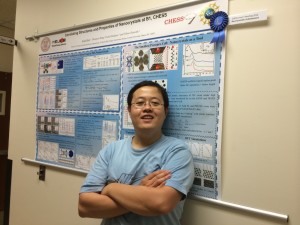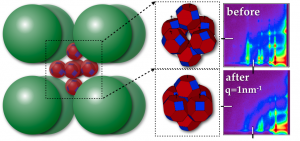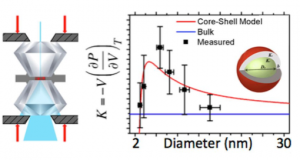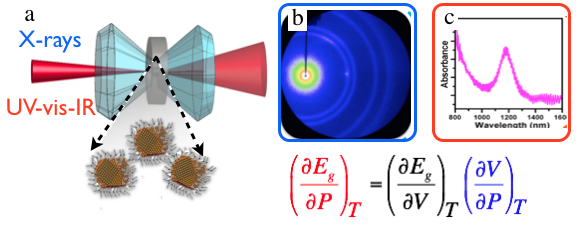Congratulations to Kaifu for winning the ‘Best Poster’ award at the 2014 CHESS Annual user meeting.

Establishing foundational structure-property relationships of nanocrystals and their assemblies
Kaifu Bian,a Zhongwu Wang,b Detlef Smilgies,b and Tobias Hanrath,a
aSchool of Chemical and Biomolecular Engineering, bCornell High Energy Synchrotron Source, Cornell University, Ithaca, NY, 14853
This poster will summarize our recent work at the B1 beamline of CHESS. Assemblies of nanocrysals present many interesting scientific challenges at the confluence of hard and soft matter physics. The B1 station at CHESS presents unique experimental capabilities to probe novel materials under pressure. High-pressure experiments provide new insights into basic structure property relationships. The poster summarizes three recent projects: (1) pressure-dependent optical properties of PbS NCs, (2) size-dependent compressibility of PbS NCs, and (3) utilizing nanocrystal superlattice as a nanostructured pressure cell.
We investigated the pressure-dependent optical properties of PbS NCs. We found that the band gap Egof PbS NCs decreases with pressure and the pressure coefficient dEg/dP depends on the size of NCs. Combining structural information of both atomic lattice and inter-particle separation measured by in-situ high-pressure WAXS and SAXS theoretical calculation reproduced the experimentally obtained pressure-dependent variation of band gap. A second important discovery is the disappearance of the excitonic peak as the particles undergo the high-pressure rock-salt to orthorhombic phase transition. The pressure-induced changes in crystal structure and electronic structure are reversible. Taken together, our results provide new insights into the size- and pressure-dependent electronic structure of PbS nanocrystal quantum dots.
Our analysis of wide-angle X-ray scattering of PbS NCs under pressure also revealed that compressibility of PbS NCs, like many other properties, is size-dependent. We discovered a maximum stiffness at particle size of about 7 nm. We tentatively attribute this trend by a core-shell model. The size-dependent stiffness of nanocrystals is caused by difference in the elasticity between atoms near the center of a nanocrystal and those at the surface.
Finally, we present our recent demonstration of the nanocrystal superlattice pressure cell. We showed, for the first time, opportunities introduced by the use of nanocrystal superlattice as an experimental platform to probe moleculer bundles under uniaxial compression. We used the assembly itself as a nanoscale pressure cell to probe molecular bundles under uniaxial compression. We report a novel method to uniaxially compress molecules within specific confined spaces of a nanocrystal superlattice. We combined X-ray scattering experiments with density functional theory simulations demonstrate our method to probe the elastic force of single molecule as a function of chain length. We see this methodology as an exciting new opportunity to investigate structure-function relationships of molecules under uniaxial compression.
 ghs in the creation of materials with properties by design continue to emerge from our ability to precisely control size, shape and composition of materials at the nanometer level. Assembling these materials into multi-component superlattices opens new horizons to create new materials with unprecedented properties. Controlling the interactions between nanocrystals in the superlattice critically depends on improved understanding of the local structure of the connections between the dots.
ghs in the creation of materials with properties by design continue to emerge from our ability to precisely control size, shape and composition of materials at the nanometer level. Assembling these materials into multi-component superlattices opens new horizons to create new materials with unprecedented properties. Controlling the interactions between nanocrystals in the superlattice critically depends on improved understanding of the local structure of the connections between the dots.









